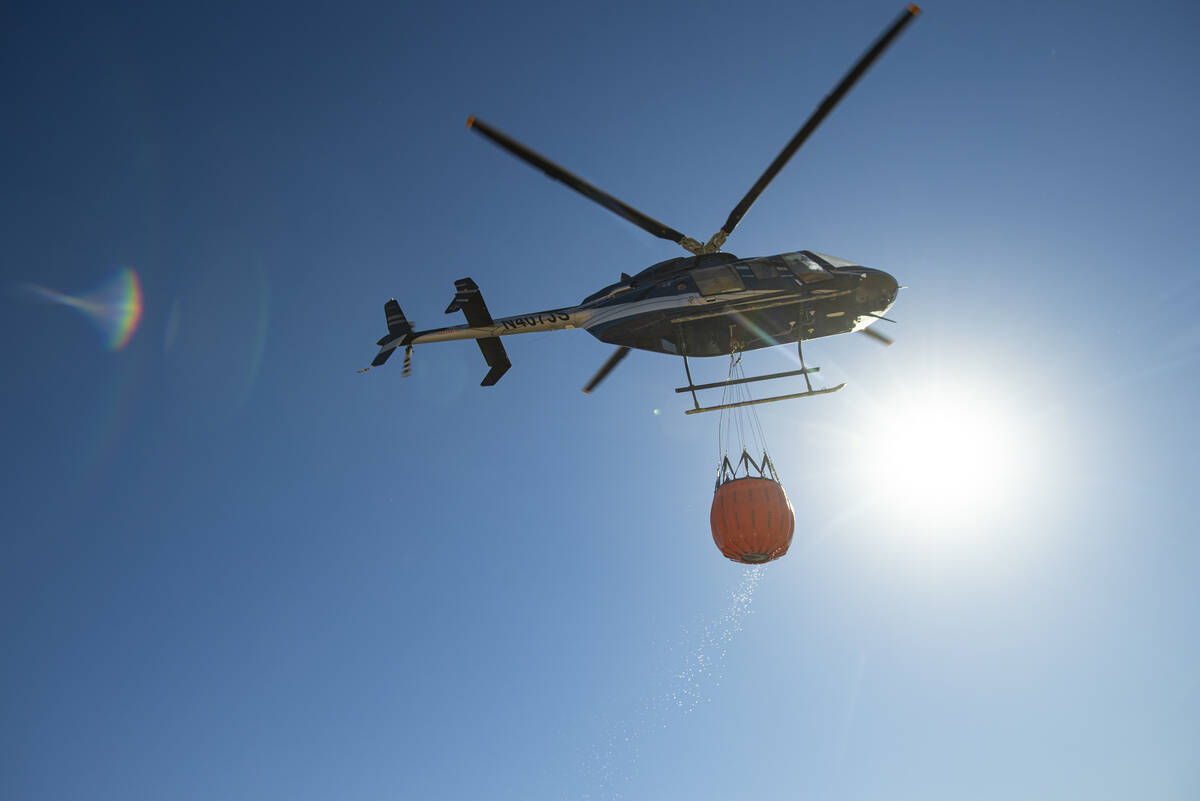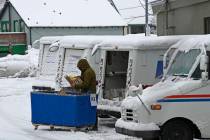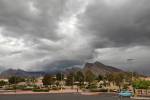Nevada’s long-term dry spell: Megadrought or new normal?
Last year saw the most intense period of drought in Nevada in the U.S. Drought Monitor’s more than 20-year history.
In Southern Nevada, 2022 hasn’t been much kinder.
As of Thursday, the Drought Monitor showed that 30 percent of the state — and over 99 percent of Clark County — is in “exceptional drought,” the most severe classification.
Through June, there have been only 0.31 inches of precipitation recorded in the county, tying 2022 with 2002 for the second driest year on record (behind 1953). The 20th-century average by June is 3.63 inches.
Stephanie McAfee, Nevada state climatologist, says conditions in Southern Nevada are comparable with those of 2021 when 41 percent of the state was in an exceptional drought. All of Clark County has been in either extreme or exceptional drought since the week of May 10.
“We’re not saying ‘oh my gosh, it’s drier than Ohio, this is a problem.’ Because it’s always drier (here) than in Ohio,” McAfee says. “What we’re saying is that it’s drier in Southern Nevada than it normally is.”
Intense drought has been a mainstay of the past few years in the county. From Nov. 10, 2020, to Aug. 17, 2021 — 40 weeks — 100 percent of Clark County was in either extreme or exceptional drought.
In Nevada, moderate droughts — the least severe classification — mean increased fire dangers and reduced forage for livestock.
Exceptional droughts, though, can have disastrous consequences on the water supply, as evidenced by plummeting water levels at Lake Mead. They also threaten wildlife and ecosystem health. Last year, the Nevada Department of Wildlife hauled in water via helicopter to support bighorn sheep populations in the state.
Drought conditions are expected to persist across the state for at least the next three months. It would take 300 percent of the normal precipitation to end the drought in Southern Nevada in that timeframe — and there’s less than a 1 percent chance of that happening. Even over the next 12 months, the odds of ending the drought stand at around 15 percent.
Drought in Southern Nevada
Nevada is no stranger to droughts. Precipitation levels in the state from year to year are among the most variable across the country.
In the 20th century, there were several dry periods in the state — for instance in the 1930s, ’50s and ’60s. And across the western United States, there have been numerous multidecade “megadroughts” over the past 1,200 years.
But the biggest difference between the current drought and historic droughts is the heat. Dan McEvoy, associate research professor of climatology at the Desert Research Institute, explains that precipitation trends haven’t significantly changed in the state over the past 128 years — but temperatures have certainly increased.
“Not every recent winter has been the driest winter on record,” McEvoy explains, “but each year is an above-average temperature year relative to our past.”
Since 1895, average temperatures have increased by 0.2 degrees per decade in Clark County. Zooming in on Las Vegas, the average temperature has climbed 0.7 degrees per decade since 1949.
Current warming trends in Nevada are also being mirrored across the Colorado River Basin, exacerbating the ongoing “megadrought” and jeopardizing the future of over 40 million people that rely on the Colorado River for their water.
Warming in the Upper Colorado River Basin is expected to reduce river flow between 14 and 31 percent by 2065, with about a 5 percent flow decrease for every degree of warming. Cumulative inflows to the Colorado River since 2000 are about 16 trillion gallons below the historical average.
“When it’s warmer, drought is more severe,” McAfee says. “Rain and snow don’t go as far.”
Higher temperatures can lead to reduced snow accumulation in the mountains of the Upper Colorado River Basin. Less snowmelt means that less water ends up in reservoirs like Lake Powell and Lake Mead.
‘Thirstier’ for water
Warming temperatures also increase the evaporative demand of the atmosphere, making it “thirstier” for water. This thirst ultimately leads to higher levels of evapotranspiration, meaning that more water from the ground and from the surfaces of plants is lost to the atmosphere.
With dry soils and parched vegetation, when the snowmelt does arrive in the spring and early summer, a lot of its water first goes into soaking dried-out soils and plants upstream of Lake Powell. A much smaller amount actually makes it to the reservoirs.
For example, McEvoy says, “Snowpack in the Upper Colorado system might be 90 percent of its average amount. That doesn’t sound too bad, but from that, in the summer, the amount of runoff that makes it to Lake Powell might be less than 50 percent of the average amount. … It’s not a direct relationship of 90 percent snowpack to 90 percent runoff.”
That’s why one wet year won’t be enough to break the current drought in the Colorado River system.
“We need a string of five to 10 mostly wet years,” says McEvoy, before conditions improve and soils become less dry, which hasn’t happened since the late 1990s.
Recent studies have argued that carbon emissions from humans are a significant driver of warming trends in the West.
One study found that impacts from humans could explain 42 percent of the drought severity from 2000 to 2021.
Because of human contributions to warming in the West, McEvoy says that the temperature increases behind much of the drying aren’t likely to go away anytime soon. Climatologists like McAfee and McEvoy have even begun to question if the ongoing megadrought is truly just a drought, or if it’s symbolic of a drier future in the western United States.
“To what level is this a megadrought?” McEvoy asks, “And to what level is this truly aridification?… Is this just our new climate state now?”
Aridification is a long-term process in which a region becomes increasingly dry.
“Droughts can still happen in a climate that’s aridifying. Wet periods can still happen in a climate that’s aridifying,” McAfee explains. “But the baseline is moving.”
Experts say that users of the Colorado River will likely have to adjust to living with less water in the long term. Federal officials have called for sweeping cuts to water usage across the states who rely on the Colorado River in response to falling water levels at Lake Powell and Lake Mead.
“We mostly look at water levels in Lake Powell and Lake Mead as alarm bells for what’s going on with the water supply,” McEvoy says. In recent years, he explains those alarm bells have become loud and clear. “We need to start making changes fast.”
Colton Poore is a 2022 Mass Media reporting fellow through the American Association for the Advancement of Science. Email him at cpoore@reviewjournal.com or follow him on Twitter @coltonlpoore.
Conserving water
Southern Nevadans are used to conserving water, but during a drought, water conservation is even more critical.
The Southern Nevada Water Authority and Las Vegas Valley Water District encourage residents to stop water waste by complying with watering regulations.
From May 1 to Aug. 31, sprinkler watering is prohibited between 11 a.m. and 7 p.m. every day. Watering on Sunday isn't allowed. Residents should also check for leaks in and around their homes.
When you do water, "make sure that water from your sprinklers isn't sprinkling your driveway," advises Stephanie McAfee, Nevada state climatologist. "Your driveway doesn't need to be watered."
The water authority also offers programs like the Water Smart Landscapes Rebate, which pays people to swap out grass lawns for desert-friendly landscaping. And residents can get coupons for car washes at various commercial car wash facilities around the Las Vegas Valley through the Water Smart Car Wash program.
— Colton Poore






























